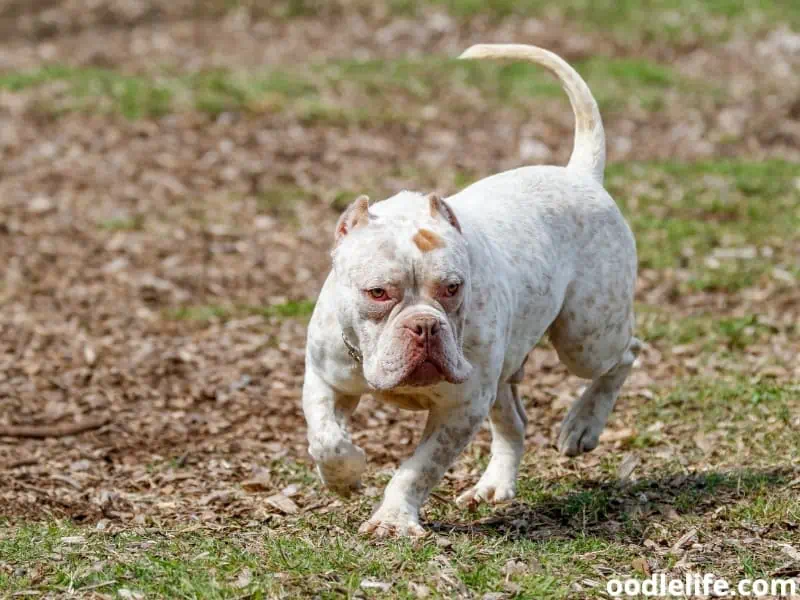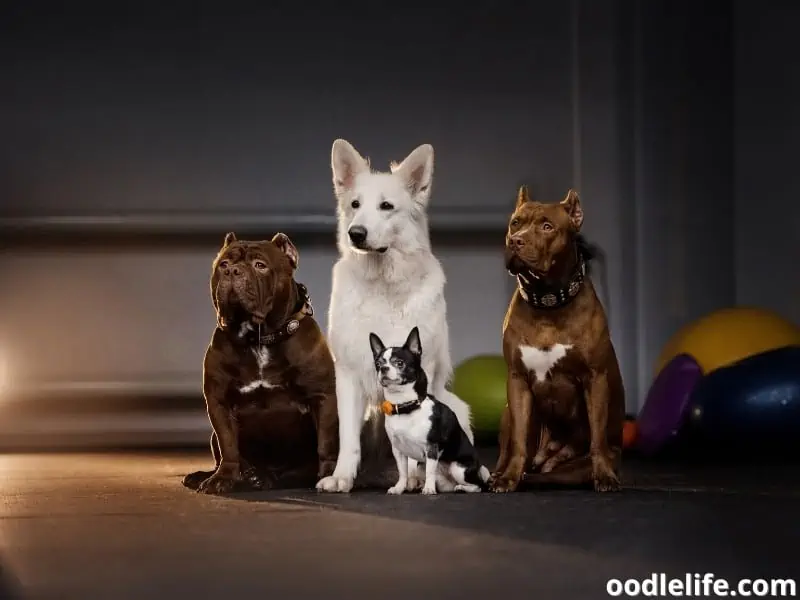7 Dog Breeds that Get Along with Pit Bulls (+ Photos)
Pit Bulls tend to be seen as the big, bad breed that people are hesitant to choose or interact with.
But the American Staffordshire Pit Bull Terrier can be a sweet and loyal dog that can also be well-behaved if it is trained properly.
If you have a Pit Bull that you adore and want to add a new furry friend to the family or know what breeds to let your pup interact with, below are the top seven breeds that are thought of as getting along well with Pit Bulls.

Top 7 Dog Breeds That Love Pit Bulls
Your lovable Pit Bull could find its new best friend in one of these breeds.
1. German Shepherds
German Shepherds are the best breed to pair with a Pit Bull. Both have aggressive play styles, so they can match each other’s energy and temperament. Plus, German Shepherds are large enough to defend themselves if an interaction doesn’t go well.
Because both breeds are so stubborn and lively, it can be stressful to introduce them. But if done right, they can make perfect playmates for one another. Ensure that you monitor them for the first few weeks until they know each other.

2. Siberian Huskies
Siberian Huskies are another strong-willed breed that gets along with Pit Bulls. Both enjoy roughhousing and have strong jaws, so they are matched evenly. Plus, both are teeming with energy and playfulness.
Huskies and Pit Bulls both tend to love toys and adventures. These breeds form an excellent pair that can go on hikes, visit the beach, play fetch, or lie beside one another and gnaw on a bone. Both these breeds are highly trainable if you are willing to do the work.

3. Dobermans
Dobermans are large, tough dogs that make excellent playmates and friends for a Pit Bull. Dobermans are typically faster and taller than Pit Bulls, so they’ll also be matched evenly if things get out of hand. Having two strong breeds like this together can be intimidating, but it also means they’re a match made in heaven.
When you have a Pit Bull and Doberman, make sure you have plenty of space for them to play and run around or to get away from each other if necessary. While Pit Bulls can be cuddly and clingy, Dobermans often prefer alone time every once in a while.

Veterinarian Dr Charlotte Stiles (DVM)
4. Basenjis
A Basenji is a great breed to pair with a particularly unfriendly Pit Bull. Basenjis are not very reactive or aggressive but are strong enough to stand up for themselves if a dog bothers them. Basenjis are usually slightly smaller than Pit Bulls, so your Pit Bull won’t feel threatened.
Most Pit Bulls bark rarely and do not like dogs that bark often. Basenjis don’t have the vocal cords that allow dogs to bark, so you will never hear them. If you have a sensitive Pit Bull, Basenjis are one of the best choices to pair it with.

5. Basset Hounds
If you’re looking for a dog very different from a Pit Bull, Basset Hounds are a great choice. They are not aggressive or reactive dogs; instead, they are super gentle and easygoing. They have moderate energy, so they won’t make the best playmate for a Pit Bull, but they can be a low-key companion.
Basset Hounds are also pack dogs, so they’ll love being around the Pit Bull, even if they aren’t necessarily best friends.

6. Beagles
Beagles are an excellent companion for Pit Bulls thanks to their gentle and friendly nature. Beagles are not very threatening, so Pit Bulls often don’t feel as territorial around them. Beagles are playful enough to make a great buddy for a Pit Bull.
Beagles are famous for being pack dogs, which means they thrive in the company of other dogs. They also prefer company rather than solitude, and Pit Bulls are the same. Some breeds like alone time, but these two breeds will find comfort in each other’s company and will likely become wonderful friends when properly introduced.

7. Rottweilers
Rottweilers can make a great companion for a tough, high-energy Pit Bull. Both breeds can be dog-aggressive, but they can be best friends if introduced properly and slowly.
Experts recommend pairing a younger Rottweiler with an older Pit Bull, as this scenario will intimidate the Pit Bull less. Together, these dogs have a lot of energy and playfulness. Be prepared for lots of walks and endless playtime.

Tips For Introducing Dogs
Follow these general tips for introducing two dogs.
Go Somewhere Neutral
Dogs are territorial animals, so it’s best not to introduce dogs in a location where one of them might feel the need to protect its space. Don’t bring one dog to another dog’s house or somewhere else where it might feel territorial.
Dog parks and other public spaces are excellent locations to introduce dogs. Try to find an isolated park or go at a time when there won’t be many other people or dogs.

Be Outside
Dog introductions go much better when they occur outdoors. Introducing dogs indoors, especially in a tight space, can cause immediate friction and discomfort between the two dogs.
Even an introduction in a small park or yard isn’t the best-case scenario. Plus, they might cause some damage to the house if they get too rowdy, whether playful or not.

Allow for Off-Leash Interaction
While it might seem risky, it’s usually better to introduce dogs off-leash. When dogs are on a leash, it can make them feel agitated and less in control of the situation, especially when there’s another dog around.
Placing dogs on a leash might make them feel more connected to their owners and more protective. If you feel comfortable dropping the leash or taking the leash off the dogs, this can be a chance for them to interact and sniff each other freely.

Monitor Body Language
When monitoring dogs, whether it’s their first interaction or not, it’s vital to know the meaning behind their body language. Bouncy playing and tail-wagging are good signs. Stiff bodies, snarled teeth, and the hair on their back standing up are not good signs.
Before introducing the dogs, research what different body language indicates, so you know when to intervene. Remember, dogs don’t play how humans do, so something you think is aggressive might simply be playful.

Stay Positive
Keep your voice and actions positive. Punishing a dog for behaving badly toward another dog might not yield the results you want. The dog that receives the punishment might associate the negative action with the other dog, not its own actions.
Consistently reward good playing and positive interactions and don’t punish the dog for negative interactions. Instead, separate the dogs when things go south, whether for a few minutes or a few days.

What to Consider When Choosing a Second Dog?
Before you adopt or buy a second dog, consider the following factors that might impact your current dog’s comfort in its home.
Gender
When choosing a second dog, don’t get the same gender as your current dog. This is especially true with female dogs, as they can be especially territorial and aggressive toward dogs of the same sex. If you have a male dog, getting a female dog is the best move and vice versa.

Age
Try not to get a second dog with a major age difference from your current dog. They should be about the same age, give or take a year. The reason for this is simple – younger dogs will have more similar mindsets to each other and older dogs will too.
Older dogs are less likely to run around and play, while young dogs are higher energy and usually get along better. Older dogs can also get moody, and it’s harder for them to handle change.

Size
Try to get a second dog of similar size. Getting a large second dog can make your smaller dog feel intimidated. And getting a small dog might not give your other dog the playmate it wants.
This is especially true if you have a Pit Bull, as they typically prefer larger dogs and larger dogs prefer them.

Breed
As this article discusses, some breeds get along better than others. If you have a Pit Bull, try to get one of the seven dogs mentioned in this article, as it might make for a smoother transition.
Every dog is different, no matter its breed, so you won’t know for sure until the dogs meet and interact for a while.

Final Words
Remember, a dog is not its breed. Every dog is different and might not fit into its breed characteristics. Always use caution when introducing dogs to each other and be ready to separate them.
Generally, Pit Bulls can get along with a dog of any breed if it has the right temperament and a positive introduction.